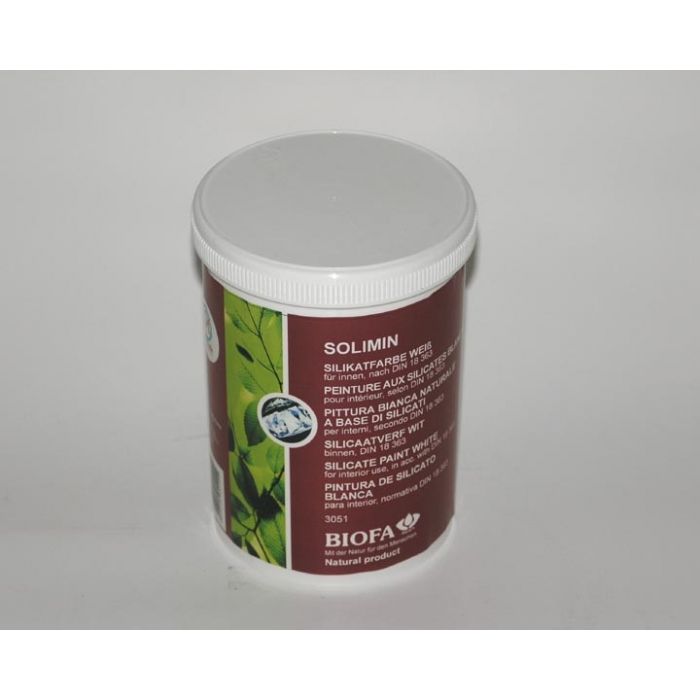Biofa Solimin 3051
This paint stands out for its satisfactory diffusion permeability (equivalent air film thickness (sd) = < 0.011 m), coverage and abrasion resistance.
Non-flammable, hypoallergenic and quick-drying. The product's alkalinity gives it a disinfectant action. This paint is particularly suitable for use in public buildings and for treating walls and ceilings in living rooms, bathrooms, kitchens, stairwells and cellars. Ideal for damp rooms. Can be applied to the following substrates: lime, cement, plaster and clay plaster, concrete, sand-lime brick, exposed brickwork, oatmeal husk paper, fiberglass fabrics and old mineral or dispersion paints.
This product can also be used as a primer before glazing with BIOFA wall glazes.
Process steps :
1. Pre-treatment
Substrate must be dry, clean and stable. Completely remove all traces of lacquer, latex, oil or synthetic resin-based paint.
Alkali-sensitive surfaces must be protected! Cracks, crevices, shrinkage cracks and other damage to plaster should be carefully filled with
with putty. Remove traces of formwork oil with a suitable detergent or soap solution, then rinse thoroughly with water.
Sand down laitance. Observe the drying time for concrete or plaster before treatment:
Minimum drying time for concrete: 30 days
Minimum drying time for coating : 10 days.
Particularly friable or absorbent substrates should be pre-treated with Universal 1440 fixative.
Particularly smooth substrates such as gypsum plasterboard can be given greater structure and adhesion by pre-treating them with BIOFA SOLIMIN Quarz white 3055 quartz plaster.
Caution!
When applying BIOFA SOLIMIN mineral paint, followed by a wall glaze, to dry construction panels (Rigips, Fermacell, etc.) or to plastered substrates that have undergone major repairs, undiluted SOLIMIN 3046 Undercoat must first be applied to the entire surface of the substrate, after filling and sanding. Unthinned mineral paint should be applied in thin coats at the same time, as jointing and patching areas may reappear, and the panels may become excessively damp and crack formation may increase if the mineral paint is diluted too much.
SOLIMIN 3046 Undercoat must also be applied before painting non-woven coverings.
For stripped surfaces, light sanding (60 to 100 grit) and thorough dusting (sweeping or vacuuming, followed by damp sponging) or thorough cleaning with a brush and hot water are recommended.
After drying for 24 hours, treat surfaces with Universal 1440 fixative. Upholstery adhesive residues are likely to cause adhesion problems.
Important information : When applying open-pore waterborne paints to various substrates, substances such as lignin, nicotine or rust, as well as various salts and humidity, can cause perforations, discoloration or color deviations. For this reason, it is essential to check the compatibility of the substrate and carry out preliminary tests (sample areas). Watch out for VOCs!
2. Base coat
Stir SOLIMIN mineral paint thoroughly and apply with a brush, roller or Airless spray gun. For bright shades, mix SOLIMIN color with SOLIMIN white 3051 mineral paint in equal parts. The first coat can be thinned to 5 or 10% with water or Universal 1440 fixative.
In the case of highly absorbent or powdery substrates, the mineral paint should only be thinned with Universal 1440 fixative.
Important: Ensure even paint application! Close to and along edges, work wet-on-wet! Use only soft rollers capable of absorbing sufficient paint! Pre-testing is recommended! Ensure optimum fresh-air ventilation during application and drying! Do not apply
at temperatures below 5°C!
3. Top coat
The topcoat is applied undiluted. If necessary, thin to 3 or 5% by adding water or Universal 1440 fixative.
4. Cleaning tools
Wash tools immediately after use with water and BIOFA 0600 brush cleaner. Remove dry stains with BIOFA NATOLE 4060.
Drying
SOLIMIN white paint after approx. 5 hours; SOLIMIN color paint after 16 to 24 hours. Allow to dry for at least 24 hours before applying any glaze coat.
| Destination | Ceilings |
|---|---|
| VOC | < 1 gr/L |





